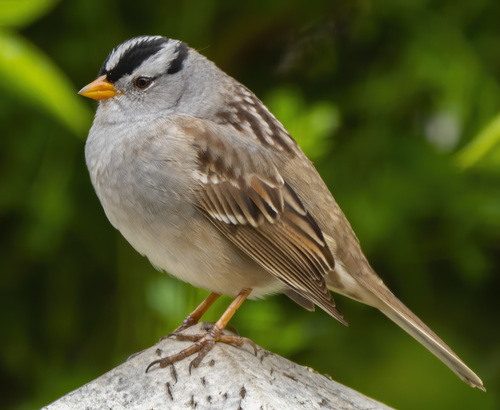
White-crowned Sparrow
The White-crowned Sparrow (Zonotrichia leucophrys) is a widespread and well-studied North American songbird, recognized for its distinctive black and white striped crown. It plays a significant role in seed dispersal and insect control within its diverse habitats. While not currently considered globally threatened, some subspecies face localized pressures. This sparrow is a model organism in studies of bird song, migration, and adaptation to varying environments, making it a species of considerable scientific interest.
15-18 cm
Length
21-25 cm
Wingspan
Least Concern
Conservation Status
Distribution
Breeds across northern North America, from Alaska and Canada to parts of the western and northeastern United States. Migrates south for the winter, reaching much of the contiguous United States and northern Mexico. Some populations are resident year-round, particularly along the Pacific coast.
Lifespan
Up to 13 years in the wild, although most live significantly shorter lives (average 2-3 years).
White-crowned Sparrow's Habitat
Habitat Types
Tundra, Taiga, Open woodlands, Shrublands, Forest edges, Mountain meadows, Coastal scrub
Climate Zones
Subarctic, Temperate, Boreal
Adaptations
Adaptable to a wide range of altitudes and vegetation types. Northern populations are highly migratory, while southern populations may be resident or only move short distances. Their physiology and behavior are adapted to cope with cold temperatures and seasonal food availability.
Variations
Five recognized subspecies exist: *Z. l. leucophrys, Z. l. gambelii, Z. l. nuttalli, Z. l. pugetensis, and Z. l. oriantha*. These differ subtly in plumage, song, and migratory behavior. *Z. l. nuttalli* is a non-migratory resident of coastal California.
Appearance
Breeding Plumage
Adults have a distinctive black and white striped crown during the breeding season. Non-breeding plumage is similar, but the crown stripes may be less defined, appearing more brownish.
Seasonal Feather Changes
Juveniles have a brown-streaked head and lack the bold crown stripes. They molt into their adult-like plumage during their first fall.
Sex Based Plumage Differences
Males and females have very similar plumage.
Notable Features
Bold black and white stripes on the crown (adults)., Grayish-brown upperparts with darker streaks., Pale gray underparts., Pinkish bill.
Diet and Feeding
Primary Foods
Seeds, Insects, Spiders, Berries, Small fruits
Foraging Behavior
Forages primarily on the ground, hopping and scratching among leaf litter and low vegetation. Also gleans insects and seeds from plants. Often feeds in small flocks, especially during migration and winter.
Specializations
No highly specialized feeding adaptations. Their diet is relatively broad and opportunistic, allowing them to thrive in a variety of habitats.
Seasonal Diet Variations
Diet shifts seasonally. During the breeding season, insects and other invertebrates are a major food source, providing protein for growing chicks. In winter, seeds and berries become more important.
Behavior
Social Structure
Territorial during the breeding season, forming monogamous pairs. Outside of the breeding season, often forms flocks, sometimes mixed with other sparrow species.
Communication
Complex songs, with regional dialects., Variety of call notes, including a sharp 'chip' and a thin 'seet'.
Migration
Most populations are migratory, traveling long distances between breeding and wintering grounds. Migratory routes and timing vary among subspecies. *Z. l. gambelii* is known for its impressive long-distance migration.
Territorial or Group Behaviors
Males defend territories during the breeding season through song and aggressive displays. In winter, flocks establish dominance hierarchies.
Conservation
Threats
Habitat loss and degradation (due to agriculture, urbanization, and logging)., Climate change (affecting breeding habitat and food availability)., Pesticide exposure., Collisions with buildings and vehicles.
Protection Programs
General protections under the Migratory Bird Treaty Act in the US and Canada., Habitat conservation efforts by various organizations.
Local National Laws
Protected under the Migratory Bird Treaty Act in the United States and similar legislation in Canada.
Population Trend
Generally stable, although some populations may be declining locally.
Population Estimates
Global population estimated to be around 120 million individuals.
Interesting Facts
White-crowned Sparrows have distinct song dialects.
Different populations have unique song variations, much like regional accents in human language. These dialects are learned, and young birds learn the songs of their local area.
They are capable of impressive feats of endurance during migration.
Some subspecies can fly hundreds of miles in a single night. Studies have shown they can go without sleep for extended periods during migration.
They are a model organism for studying sleep deprivation.
Their ability to remain active with little sleep during migration has made them a subject of research into the effects of sleep loss.
Some populations are non-migratory.
The subspecies *Z. l. nuttalli* is a year-round resident along the coast of California.
Faqs about White-crowned Sparrow
What do White-crowned Sparrows eat?
They eat a variety of seeds, insects, spiders, berries, and small fruits. Their diet changes seasonally, with more insects during the breeding season and more seeds in winter.
Where do White-crowned Sparrows build their nests?
They typically build cup-shaped nests on the ground or low in shrubs, often well-concealed by vegetation.
Are White-crowned Sparrows endangered?
No, they are classified as Least Concern by the IUCN. However, some populations may be facing local threats.
How can I attract White-crowned Sparrows to my yard?
Provide a source of fresh water, offer bird feeders with mixed seeds (especially white millet), and maintain a brush pile or dense shrubbery for cover.
How long do White-crowned sparrows live?
Up to 13 years in the wild, although most live significantly shorter lives (average 2-3 years).
Copyright @ Nature Style Limited. All Rights Reserved.
 English
English